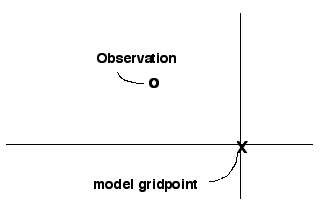There are three questions, each worth the points listed by the question.
![]() Time
allowed: 60 Minutes
Time
allowed: 60 Minutes
You can use Holton, An Introduction to Dynamic Meteorology, Oort and Peixoto, Physics of Climate, and your class notes.
1. [20 points] Optimal Interpolation
For this problem, assume that
ZP = 5000 m
at both the observation point and the model gridpoint. Also assume that
ZO = 5500 m, EP = 500 m, EO = 100 m
and that the forecast error correlation function is given by
![]()
where r1k is the distance separating the observation and the model gridpoint.

(a) Suppose the observation point and model gridpoint are separated by 1 km. What is the analysis error for the model gridpoint?
(b) How far must the observation be from the model gridpoint for the analysis error to be one half of EP ?
(c) Suppose the observation and model gridpoint are separated by 100 km. Using the observation above what is the analysis value ZA at the model gridpoint?
2. [20 points] NWP
The balance equation used in the forecast system to eliminate gravity waves is
![]() ,
,
where we assume vertical motion is negligibly small.
(a) Very briefly (one or two sentences) — why did early NWP scientists want to eliminate gravity waves from their equations?
(b) A gravity wave solution to the shallow water equations is
![]()
and ![]()
where ![]() ,
under the assumption of no background flow. H is a constant.
,
under the assumption of no background flow. H is a constant.
What is vorticity (z) for this gravity wave?
(c) Show (clearly) that this solution can not satisfy the balance equation above, thus implying that gravity waves can not be contained in the set of filtered NWP equations used in early numerical weather prediction.
3. [20 points] Initialization
(a) Suppose an analysis (including its estimate of errors) tells us that
fu = -10-3 m-s-2 ± 10-4 m-s-2
![]() = + 10-3
m-s-2 ± 10-4 m-s-2
= + 10-3
m-s-2 ± 10-4 m-s-2
What is the range of possible accelerations dv/dt given the two terms above and their errors?
(b) Give one brief reason why an analysis can give erroneous accelerations in the momentum equation (thus motivating the use of initialization).